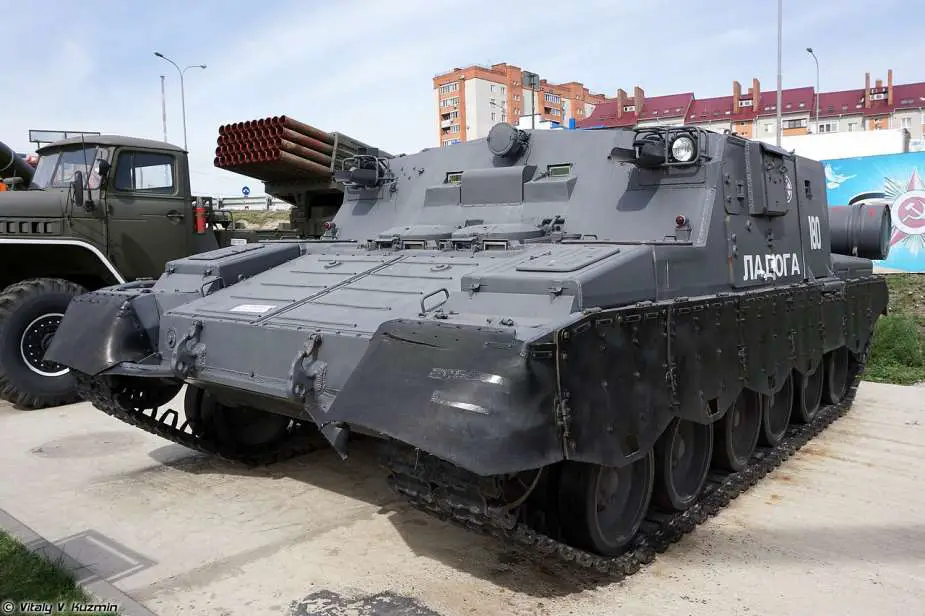On March 24, 2024, the Moon Planet drone unit of the Ukrainian 63rd Mechanized Brigade located and targeted a Ladoga, a highly protected vehicle of which a maximum of five units were produced. This heavy command, staff, and special-purpose reconnaissance vehicle, based on a T-80 tank chassis, was initially deployed during the Chernobyl nuclear disaster in 1986, where it was used to conduct reconnaissance and assess the radioactive environment following the reactor explosion.
Follow Army Recognition on Google News at this link

The most test of the Lagoda vehicle came during the Chernobyl nuclear disaster in 1986, where it was used to conduct reconnaissance across the radioactive environment. (Picture source: Moon Planet and Russian social media)
Despite its age and rarity, the Lagoda has been reconsidered for use in active operations by the Russian Army in Ukraine, possibly influenced by the reported losses since the start of the invasion; Russian Forces experienced a total of 274 losses in command posts and communications vehicles, along with 417 armored personnel carriers (APCs), according to available data. These losses might explain the necessity for the Russian Forces to revisit their equipment inventory, considering the reactivation of previously retired assets to meet the demands of ongoing military operations, especially in situations where there are no immediate replacements. Additionally, the vehicle’s design, which is based on the T-80 tank, allows for relatively straightforward maintenance, a factor that could be considered advantageous in conflict zones like Ukraine. This situation reflects the pragmatic approach sometimes required in military logistics and strategy.
The development of the highly protected vehicle (HPV) "Ladoga" was initiated by the Soviet Union during the late 1970s in response to a Soviet Army's requirement for a new class of armored vehicles capable of operating autonomously in environments with high levels of radiation, chemical, or bacteriological contamination. Classified as a heavy command, staff, and special-purpose reconnaissance vehicle, this project was undertaken by SKB Transmash, later known as JSC Spetsmash, using the T-80 tank chassis as a foundation.
The design and development responsibilities of the Ladoga were assigned to the KB-3 unit of the Leningrad Kirov Plant, led by deputy general designer V.I. Mironov. The KB-3 unit focused on ensuring that the vehicle could maintain effective communication and ensure a high level of protection against environmental hazards while ensuring their comfort. By 1982, the project saw the formation of a specialized design unit, KB-A, to focus on the development of the Lagoda vehicle.
The chassis of the T-80 tank was used as the starting point for the Ladoga, facilitating maintenance and repairs by using existing military technology, with modifications such as the removal of the turret and the incorporation of a new superstructure constructed from armored steel to house the crew and equipment. To feature an ergonomic and comfortable interior for the occupants, this superstructure features life support systems similar to those found in space exploration, including air conditioning, individual lighting, an anti-neutron lining, and advanced communications equipment to ensure that the crew can operate in sealed conditions safely and comfortably.
Internally, the Ladoga was divided into two main sections: a control compartment at the front and a main compartment for passengers, typically high-ranking officials, equipped with necessary facilities for extended operations. The vehicle is equipped with a range of communication devices, potentially including capabilities for controlling strategic nuclear forces, and surveillance equipment, including a mast with cameras for all-around visibility.
The vehicle retained the T-80’s transmission and gas turbine engine, either the GTD-1000TF or GTD-1250, but featured additional systems such as a dust-blowing mechanism for the engine blades and a separate power supply unit for stationary operations to aid in operation and decontamination in affected areas. In terms of technical characteristics, the Ladoga weighs 42 tons and accommodates a crew of two, plus an additional four personnel. It can reach speeds of up to 70 km/h and has a range of 330 kilometers. The vehicle is capable of crossing trenches more than 2m wide, surmounting one-meter high obstacles, and fording water up to 1.2 meters deep.
The Ladoga prototype underwent rigorous testing across various terrains, from deserts to mountain ranges. Its most significant operational test came during the Chernobyl nuclear disaster in 1986, where it was used to conduct reconnaissance and assess the radioactive environment following the reactor explosion. This deployment allowed for the collection of critical data, showcasing its functionality by supporting cleanup efforts in the contaminated zone. During the period between May 3 to August 9, 1986, the vehicle covered a distance of over 4,720 km within the affected area. Following this deployment, the Lagoda prototype underwent decontamination and returned to the KB-3 unit of the Leningrad Kirov Plant for further use in research and development on September 14, 1986.
Despite its deployment and the capabilities demonstrated, and the fact that this vehicle still has no equivalent anywhere in the world, the Ladoga was produced in extremely limited numbers, with estimates ranging from four to five units believed to have been manufactured throughout the 1980s. Information about the operational history and specific capabilities of these vehicles remains limited, outside of its use in Chernobyl, reflecting the confidentiality typically associated with Soviet military assets designated for upper echelons of leadership.

Despite the capabilities demonstrated, the Ladoga was produced in extremely limited numbers, with estimates ranging from four to five units believed to have been manufactured throughout the 1980s. (Picture source: Vitaly Kuzmin)















